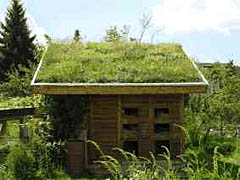
White roofing is better in summer than green roofs, says scientist
 |
During the research, scientists found that greenery can, under certain circumstances, warm the surroundings, even though this seems illogical. "We discovered that even a well-watered lawn evaporates a column of water no more than four millimeters high in hot summer days, even though the energy absorbed from sunlight would be sufficient for an evaporation of more than 12 millimeters. Similarly, a mountain spruce forest behaves. Only about four percent of the energy goes to photosynthesis, so the rest of the energy, roughly two-thirds, is converted to heat by the plants," explained Pavelka.
While lawns are better than asphalt surfaces in urban areas, vegetation coverage is by no means the best option for roofs. It is just one of the options, and it is important to consider where the roof is located and what the owner's needs are. If the roof is to remain as cool as possible and also reflect as much solar energy back, white roof coverings are more suitable. "If we theoretically wanted the city to warm up as little as possible in summer, we could paint all surfaces white, and in terms of temperatures, it would work better than lawns, but we would probably hurt our eyes and wouldn’t like it. The situation is different for roofs," suggested Pavelka.
Measurements indicated that the maximum surface temperature of white roofs on sunny hot days ranges between 40 to 48 degrees depending on the selected material. The temperature of black roofs is between 65 and 75 degrees. An intensely watered green roof had only 35 degrees during measurements, but its maintenance, especially watering, is very expensive if it doesn't rain. An unwatered grassy roof had 46 degrees, and an extensive green roof with succulents, specifically sedums, had 52 degrees. Both thus had similar or even higher temperatures than white roofs. "The costs for a regular white roof are significantly lower than for a green one," said Pavelka. There is also a significant difference in the amount of absorbed solar radiation. A white roof absorbs from 15 to 32 percent depending on the material, with the rest being reflected. "About three-quarters of the reflected radiation passes through the atmosphere back into space. Black roofs absorb over 90 percent of radiation, which they convert to heat, and then pass that into the atmosphere, which amplifies the urban heat island effect. Green roofs absorb over 80 percent of radiation and convert most of it into heat," said Pavelka. He referred to typical Mediterranean architecture featuring white houses with blue roofs.
According to him, green roofs make sense, for example, when viewed from a window, to avoid being blinded by white, and they can also provide a refuge for insects. "I am not an advocate of white roofs on all buildings, but it certainly does not make sense to universally subsidize green roofs regardless of the specific situation," said Pavelka. He also mentioned the fact that green roofs covered with succulents do not cool their surroundings at all during the day in dry periods because succulent plants only open their stomata at night to conserve water during the day.
For trees in cities, Pavelka emphasizes their ability to provide shade. "And not just for people; it also prevents paving from overheating. Moreover, there is multi-layered shading, and older, larger trees have the greatest effect," said the scientist. His colleagues Daniel Kopkáně and Jan Novotný also studied what would be the appropriate mowing height for grass to prevent the area from overheating and for the lawn to thrive. They found that approximately ten to 30 centimeters would be suitable. "As a good compromise, we recommend 15," Pavelka added.
The English translation is powered by AI tool. Switch to Czech to view the original text source.
0 comments
add comment











